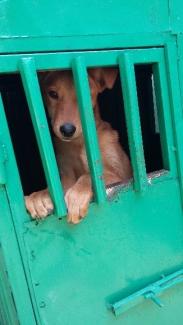Overcoming challenges with training that prevents rabies deaths
Daniel Stewart of GARC, an expert in dog behaviour and handling, gives a personal account of his recent work in Ethiopia.
May 2017 was my third visit to Ethiopia to train, encourage and continue the efforts of a combined team from Ohio State University (OSU), Centres for Disease Control and Prevention (CDC) and the Global Alliance for Rabies Control (GARC). Although the project has been running for some time, my direct involvement with the project started in August 2016 when GARC was asked to train 25 staff from the veterinary and human health departments of the Ethiopian government. Thirty people arrived and August was wet, with the rainy season in full flow and working conditions on the streets of Addis Ababa anything but pleasant.
However, over 10 days we covered bite case follow up, reading dog body language and assessing dog behaviour as well as the use of humane catching equipment. This equipment would be used in future mass vaccination campaigns. OSU and CDC veterinarians also showed the participants correct, effective and humane methods of vaccination and euthanasia. The online courses of the GARC Rabies Education Certificate and Animal Handling and Vaccination Certificate were important training tools. The team left Ethiopia having made new friends and hopefully ambassadors in the fight against Rabies.
We continued training in December 2016, when the time in Ethiopia was extended to 3 weeks. The weather was a lot drier but the previously trained cohort of staff had increased and changed, which presented some challenges. We managed to run stationery vaccination points, small door to door vaccination campaigns as well as sight re-sight surveys around two separate sub-cities. The sight re-sight survey was a start to finding out the approximate number of dogs in the city of Addis Ababa. This first 3 weeks survey certainly did not finalise the population size, but gave the team and the Ethiopian government an initial estimation. The number of dogs vaccinated was low but the gain in experience for the Ethiopians exceeded my expectations.
My next trip to Ethiopia was in May 2017, when our original CDC staff member had to be replaced due to their commitments to another disease outbreak. As normal though, the three organisations came together and managed to run a very successful training period. This trip had a lot more challenges, with 5 positive rabid dogs having to be euthanased on the streets of Addis (with one biting a member of the public in front of us).
We learned the true difficulties of getting treatment in the Ethiopia for dog bite victims, when we had to seek booster vaccines for 5 staff members who received dog bites (as a precaution not because of a positive rabid dog bite). We also experienced very serious animal welfare concerns and extremely poor sanitation in some parts of the city.
This visit we vaccinated 5,500 animals, splitting 24 trained staff into 4 groups of 2 vets, 2 animal handlers, 2 certificate writers and adding 1 survey person and a team leader from either GARC, CDC or OSU to each team. In one area we encountered a large concentration of cats living in close proximity to dogs and humans, so we vaccinated a relatively high percentage of cats.
The practicalities of working and overcoming challenges in the field can be daunting and often leads to failure and the cancelation of important vaccination campaigns. However, with professional training and organisations working together with staff on the ground, it is very clear that the confidence to overcome any obstacle can be built.



